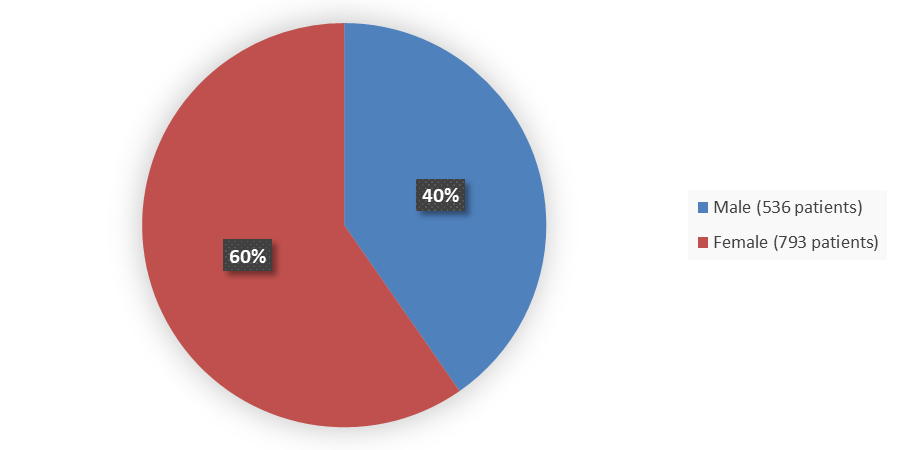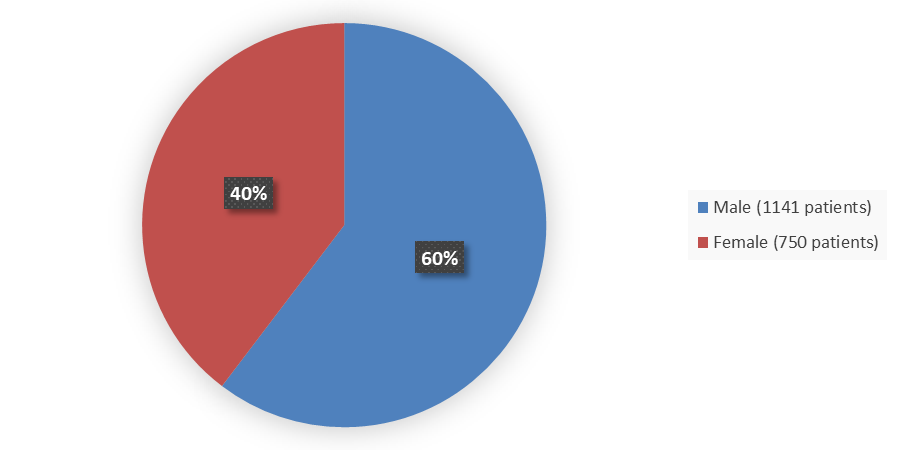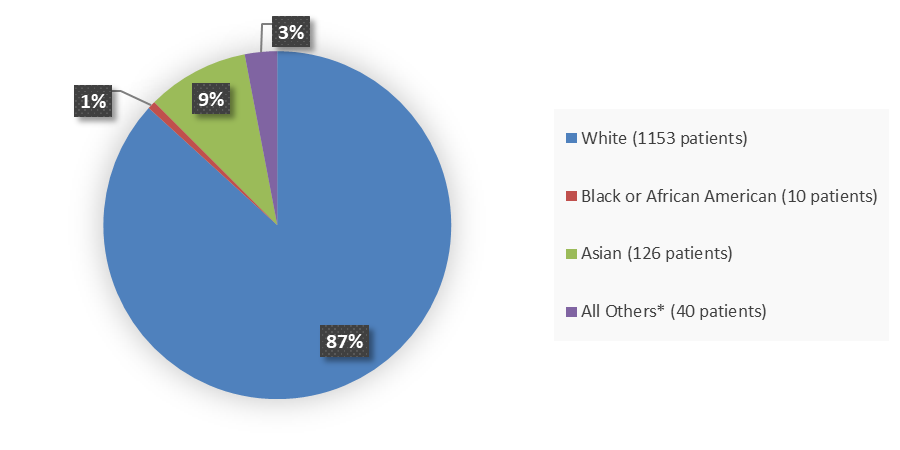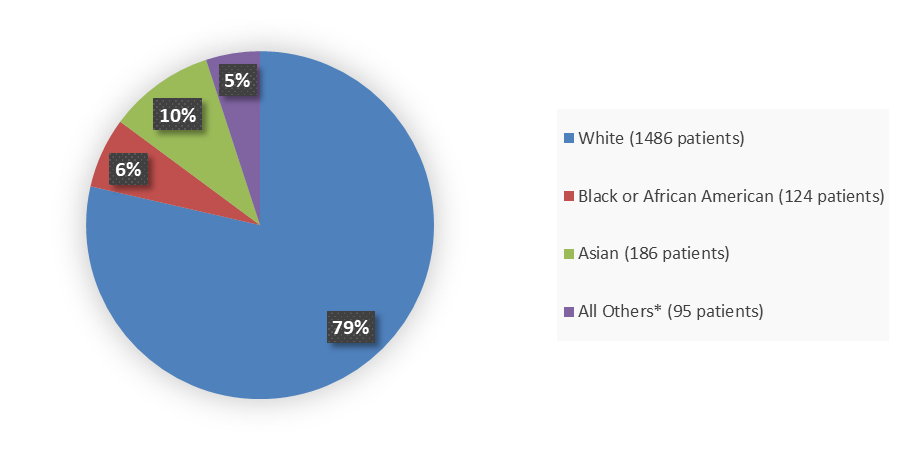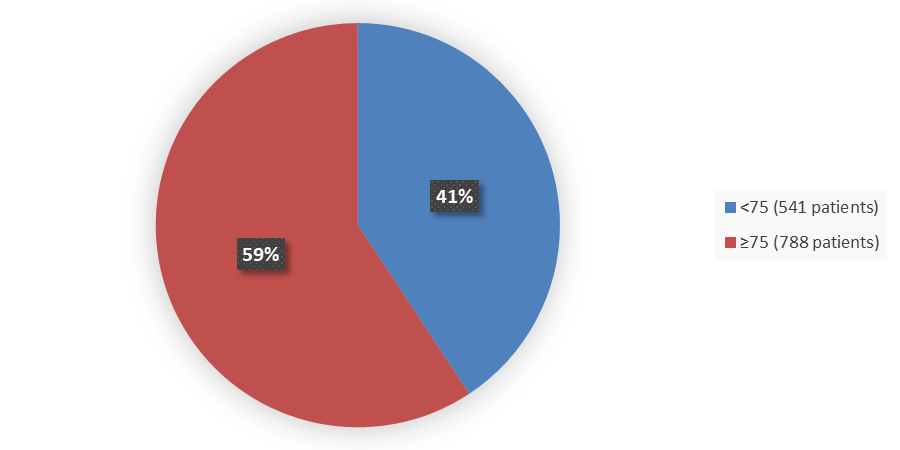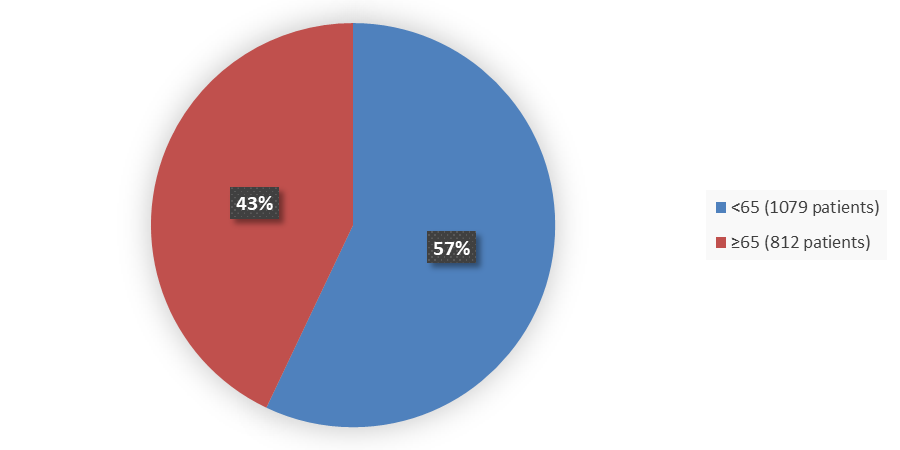Drug Trials Snapshots: VABYSMO
HOW TO USE THIS SNAPSHOT
The information provided in Snapshots highlights who participated in the key clinical trials that supported the original FDA approval of this drug, and whether there were differences among sex, race, age, and ethnic groups. The “MORE INFO” bar shows more detailed, technical content for each section. The Snapshot is intended as one tool for consumers to use when discussing the risks and benefits of the drugs.
LIMITATIONS OF THIS SNAPSHOT:
Do not rely on Snapshots to make decisions regarding medical care. Always speak to your healthcare provider about the benefits and risks of a drug.
Some of the information in this Snapshot is for presentation purposes and does not represent the approved conditions of use of this drug. Refer to the VABYSMO Prescribing Information for all of the approved conditions of use of this drug (e.g., indication(s), population(s), dosing regimen(s), safety information).
Snapshots are limited to the information available at the time of the original approval of the drug and do not provide information on who participated in clinical trials that supported later approvals for additional uses of the drug (if applicable).
VABYSMO (faricimab-svoa)
vuh-biz-moe
Genentech, Inc.
Original Approval date: January 28, 2022
DRUG TRIALS SNAPSHOT SUMMARY:
What is the drug for?
VABYSMO is a treatment for patients with neovascular (wet) age-related macular degeneration (nAMD) and diabetic macular edema (DME).
nAMD is a disease of the retina, a layer of the eye that contains cells which are sensitive to light. In nAMD, the macula (small central area of the retina) is damaged due to the growth of new blood vessels. At first, this damage causes blurred vision and then progressive vision loss.
DME is also a disease of the retina seen in some diabetics. The macula becomes swollen due to leaking fluid cause by diabetic changes in the blood vessels inside the eye.
How is this drug used?
VABYSMO is injected by a healthcare professional directly inside the eyeball every month for four months and then on a schedule based on special eye testing performed by the healthcare professional.
Who participated in the clinical trials?
The FDA approved VABYSMO for AMD based on evidence from two clinical trials (Trial 1/NCT03823287 and Trial 2/NCT03823300) of 1,329 patients, 50 to 99 years old, with nAMD.
The FDA approved VABYSMO for DME based on evidence from two clinical trials (Trial 3/NCT03622580 and Trial 4/NCT03622593) of 1,262 patients, 24 to 91 years old, with DME.
AMD Trial 1 was conducted at 149 sites in 15 countries including the United States. AMD Trial 2 was conducted at 122 sites in 20 countries including the United States. DME Trial 3 was conducted at 179 sites in 16 countries including the United States. DME Trial 4 was conducted at 174 sites in 24 countries including the United States.
How were the trials designed?
There were four total trials that evaluated the benefits and side effects of VABYSMO. Two trials were conducted in patients with nAMD, and two trials were conducted in patients with DME.
Approximately half of the patients in the AMD trials were treated with VABYSMO and the other half with aflibercept for two years. Aflibercept is an approved drug for nAMD and DME treatment.
In the DME trials, approximately one third of the patients were treated with one VABYSMO treatment regimen, one third were treated with another VABYSMO treatment regimen, and one third were treated with aflibercept. Both drugs were injected into the eye by physicians, and neither the patients nor the physicians were intended to know which treatment was being given until after the trial was completed.
The benefit of VABYSMO was assessed by measuring the change in vision acuity in patients treated with VABYSMO versus patients treated with aflibercept for the duration of the trial. Vision acuity was measured using a standard letter chart.
DEMOGRAPHICS SNAPSHOT
Figure 1. Baseline Demographics by Sex Trial 1 and Trial 2 (nAMD Safety Population)
Source: Adapted from FDA Review
Abbreviations: nAMD, neovascular (Wet) age-related macular degeneration
Figure 2. Baseline Demographics by Sex Trial 3 and Trial 4 (DME Safety Population)
Source: Adapted from FDA Review
Abbreviations: DME, diabetic macular edema
Figure 3. Baseline Demographics by Race Trial 1 and Trial 2 (nAMD Safety Population)
Source: Adapted from FDA Review
*Includes American India or Alaska Native, Native Hawaiian Or Other Pacific Islander, Multiple, and Other.
Abbreviations: nAMD, neovascular (Wet) age-related macular degeneration
Figure 4. Baseline Demographics by Race Trial 3 and Trial 4 (DME Safety Population)
Source: Adapted from FDA Review
*Includes American India or Alaska Native, Native Hawaiian Or Other Pacific Islander, Multiple, and Other.
Abbreviations: DME, diabetic macular edema
Figure 5. Baseline Demographics by Age Trial 1 and Trial 2 (nAMD Safety Population)
Soure: Adapted from FDA Review
Abbreviations: nAMD, neovascular (Wet) age-related macular degeneration
Figure 6. Baseline Demographics by Age Trial 3 and Trial 4 (DME Safety Population)
Source: Adapted from FDA Review
Abbreviations: DME, diabetic macular edema
What are the benefits of this drug?
After one year of treatment, patients treated with VABYSMO showed similar visual improvement as patients treated with an already approved drug for nAMD called aflibercept.
What are the benefits of this drug (results of trials used to assess efficacy)?
Table 1 summarizes the efficacy results for the individual Trials 1 and 2 for the nAMD indication. The primary endpoint is the mean change from baseline in Best Corrected Visual Acuity (BCVA) when averaged over the Week 40, 44, and 48 visits and measured by the Early Treatment of Diabetic Retinopathy Study (ETDRS) letter chart.
Table 1. Primary Endpoint Resultsa in Trial 1 and Trial 2
|
Endpoint |
Trial 1 |
Trial 2 |
||
|---|---|---|---|---|
|
VABYSMO |
Aflibercept |
VABYSMO |
Aflibercept |
|
|
Mean change in BCVA as measured by ETDRS letter score from baseline (95% CI) |
5.8 (4.6, 7.1) |
5.1 (3.9, 6.4) |
6.6 (5.3, 7.8) |
6.6 (5.3, 7.8) |
|
Difference in LS mean (95% CI) |
0.7 (-1.1, 2.5) |
0.0 (-1.7, 1.8) |
||
Source: VABYSMO Prescribing Information
a Average of Weeks 40, 44, and 48
Abbreviations: BCVA, best corrected visual acuity; CI, confidence interval; ETDRS, Early Treatment Diabetic Retinopathy Study; LS, least square
Table 2 summarizes the efficacy results for the individual Trials 3 and 4 for the DME indication. The primary endpoint is the mean change from baseline in BCVA at year 1 (average of the Week 48, 52, and 56 visits), measured by ETDRS Letter Score.
Table 2. Primary Endpoint Resultsa in Trial 3 and Trial 4
|
Endpoint |
Trial 3 |
Trial 4 |
||||
|---|---|---|---|---|---|---|
|
VABYSMO Q8W |
VABYSMO Variable |
Aflibercept Q8W |
VABYSMO Q8W |
VABYSMO Variable |
Aflibercept Q8W |
|
|
Mean change in BCVA as measured by ETDRS letter score from baseline (97.5% CI) |
10.7 (9.4, 12.0) |
11.6 (10.3, 12.9) |
10.9 (9.6, 12.2) |
11.8 (10.6, 13.0) |
10.8 (9.6, 11.9) |
10.3 (9.1, 11.4) |
|
Difference in LS mean (97.5% CI) |
-0.2 (-2.0, 1.6) |
0.7 (-1.1, 2.5) |
1.5 (-0.1, 3.2) |
0.5 (-1.1, 2.1) |
||
Source: VABYSMO Prescribing Information
a Average of Weeks 48, 52, and 56
Abbreviations: BCVA, best corrected visual acuity; CI, confidence interval; ETDRS, Early Treatment Diabetic Retinopathy Study; LS, least square; Q8W, every 8 weeks
Were there any differences in how well the drug worked in clinical trials among sex, race and age?
- Sex: VABYSMO worked similarly in males and females relative to aflibercept.
- Race: VABYSMO worked similarly in White and in patients from other races relative to aflibercept. Note that racial subgroup differences were investigated between White race and all other races combined because the percent of patients of a given race other than White was small.
- Age: VABYSMO worked similarly in patients younger and older than 75 years of age in Trials 1 and 2 (for nAMD indication) and younger and older than 65 years of age in Trials 3 and 4 (for DME indication) relative to aflibercept.
Were there any differences in how well the drug worked in clinical trials among sex, race, and age groups?
Table 3 summarizes Trial 1 and Trial 2 results for the primary efficacy endpoint by sex, race, and age group for the nAMD indication.
Table 3. Primary Endpoint Resultsa in Trial 1 and Trial 2 Subgroup Analysis
|
|
Trial 1 |
Trial 2 |
||
|---|---|---|---|---|
|
VABYSMO |
Aflibercept |
VABYSMO |
Aflibercept |
|
|
Sex |
||||
|
Female |
||||
|
n (%) |
191 (57.2) |
211 (62.6) |
203 (61.3) |
188 (57.5) |
|
Mean (SD) |
5.7 (0.8) |
5.1 (0.8) |
6.5 (0.8) |
6.3 (0.8) |
|
Difference in LS mean (95% CI) |
0.6 (-1.6, 2.8) |
-- |
0.3 (-1.9, 2.4) |
-- |
|
Male |
||||
|
n (%) |
143 (42.8) |
126 (37.4) |
128 (38.7) |
139 (42.5) |
|
Mean (SD) |
6.1 (1.1) |
5.3 (1.1) |
6.7 (1.1) |
6.9 (1.1) |
|
Difference in LS mean (95% CI) |
0.7 (-2.3, 3.8) |
-- |
-0.2 (-3.3, 2.8) |
-- |
|
Race |
||||
|
White |
||||
|
n (%) |
303 (90.7) |
302 (89.6) |
278 (84.0) |
270 (82.6) |
|
Mean (SD) |
5.7 (0.7) |
4.8 (0.7) |
6.4 (0.7) |
6.7 (0.7) |
|
Difference in LS mean (95% CI) |
0.9 (-1.0, 2.8) |
-- |
-0.3 (-2.3, 1.7) |
-- |
|
Others |
||||
|
n (%) |
31 (9.3) |
35 (10.4) |
53 (16.0) |
57 (17.4) |
|
Mean (SD) |
7.6 (2.0) |
8.3 (1.8) |
7.6 (1.5) |
6.0 (1.5) |
|
Difference in LS mean (95% CI) |
-0.7 (-6.0, 4.6) |
-- |
1.6 (-2.5, 5.7) |
-- |
|
Age group, years |
||||
|
<75 |
||||
|
n (%) |
130 (38.9) |
124 (36.8) |
156 (47.1) |
131 (40.1) |
|
Mean (SD) |
8.1 (1.0) |
6.7 (1.0) |
6.7 (1.1) |
7.2 (1.2) |
|
Difference in LS mean (95% CI) |
1.4 (-1.3, 4.2) |
-- |
-0.6 (-3.7, 2.5) |
-- |
|
≥75 |
||||
|
n (%) |
204 (61.1) |
213 (63.2) |
175 (52.9) |
196 (59.9) |
|
Mean (SD) |
4.3 (0.9) |
4.3 (0.8) |
6.5 (0.8) |
6.2 (0.7) |
|
Difference in LS mean (95% CI) |
0.1 (-2.3, 2.4) |
-- |
0.4 (-1.7, 2.4) |
-- |
Source: Adapted from FDA Review
a Average of weeks 40, 44, and 48
Abbreviations: BCVA, best corrected visual acuity; CI, confidence interval; ETDRS, Early Treatment Diabetic Retinopathy Study; LS, least square; Q8W, every 8 weeks
Table 4 and Table 5 summarize Trial 3 and Trial 4 results for the primary efficacy endpoint by sex, race, and age group for the DME indication.
Table 4. Primary Endpoint Resultsa in Trial 3 Subgroup Analysis
|
|
VABYSMO Q8W |
VABYSMO Variable |
Aflibercept Q8W |
|---|---|---|---|
|
Sex |
|||
|
Female |
|||
|
n (%) |
128 (40.6) |
116 (37.1) |
134 (42.9) |
|
Mean (SD) |
10.2 (0.9) |
10.8 (0.9) |
11.3 (0.9) |
|
Difference in LS mean (97.5% CI) |
-1.1 (-3.9, 1.7) |
-0.5 (-3.3, 2.4) |
|
|
Male |
|||
|
n (%) |
187 (59.4) |
197 (62.9) |
178 (57.1) |
|
Mean (SD) |
11.0 (0.7) |
12.0 (0.7) |
10.7 (0.7) |
|
Difference in LS mean (97.5% CI) |
0.4 (-2.9, 2.7) |
1.4 (-0.9, 3.7) |
|
|
Race |
|||
|
White |
|||
|
n (%) |
241 (76.5) |
240 (76.7) |
253 (81.1) |
|
Mean (SD) |
11.0 (0.6) |
12.3 (0.6) |
11.6 (0.6) |
|
Difference in LS mean (97.5% CI) |
-0.6 (-2.5, 1.3) |
0.7 (-1.1, 2.6) |
|
|
Others |
|||
|
n (%) |
74 (23.5) |
73 (23.3) |
59 (18.9) |
|
Mean (SD) |
9.6 (1.4) |
9.2 (1.4) |
7.8 (1.6) |
|
Difference in LS mean (97.5% CI) |
1.8 (-3.0, 6.6) |
1.4 (-3.4, 6.2) |
|
|
Age group, years |
|||
|
<65 |
|||
|
n (%) |
188 (59.7) |
169 (54.0) |
180 (57.7) |
|
Mean (SD) |
12.2 (0.7) |
13.2 (0.8) |
12.4 (0.7) |
|
Difference in LS mean (97.5% CI) |
-0.2 (-2.5, 2.2) |
0.8 (-1.6, 3.2) |
|
|
≥65 |
|||
|
n (%) |
127 (40.3) |
144 (46.0) |
132 (42.3) |
|
Mean (SD) |
8.3 (0.8) |
9.7 (0.8) |
8.8 (0.8) |
|
Difference in LS mean (97.5% CI) |
-0.5 (-3.1, 2.1) |
0.9 (-1.7, 3.4) |
|
Source: Adapted from FDA Review
a Average of Weeks 48, 52, and 56
Abbreviations: BCVA, best corrected visual acuity; CI, confidence interval; ETDRS, Early Treatment Diabetic Retinopathy Study; LS, least square; Q8W, every 8 weeks
Table 5. Primary Endpoint Resultsa in Trial 4 Subgroup Analysis
|
Summary |
VABYSMO Q8W |
VABYSMO Variable |
Aflibercept Q8W |
|---|---|---|---|
|
Sex |
|||
|
Female |
|||
|
n (%) |
123 (38.8) |
120 (37.6) |
129 (41.0) |
|
Mean (SD) |
11.6 (0.8) |
9.7 (0.8) |
10.4 (0.8) |
|
Difference in LS mean (97.5% CI) |
1.2 (-1.4, 3.8) |
-0.7 (-3.4, 1.9) |
|
|
Male |
|||
|
n (%) |
194 (61.2) |
199 (62.4) |
186 (59.0) |
|
Mean (SD) |
11.9 (0.7) |
11.4 (0.6) |
10.1 (0.7) |
|
Difference in LS mean (97.5% CI) |
1.7 (-0.4, 3.9) |
1.2 (-0.8, 3.3) |
|
|
Race |
|||
|
White |
|||
|
n (%) |
250 (78.9) |
249 (78.1) |
253 (80.3) |
|
Mean (SD) |
11.8 (0.6) |
10.8 (0.6) |
9.9 (0.6) |
|
Difference in LS mean (97.5% CI) |
1.9 (0.1, 3.8) |
0.9 (-1.0, 2.7) |
|
|
Asian |
|||
|
Others |
|||
|
n (%) |
67 (21.1) |
70 (21.9) |
62 (19.7) |
|
Mean (SD) |
11.6 (1.2) |
10.6 (1.1) |
11.5 (1.2) |
|
Difference in LS mean (97.5% CI) |
0.1 (-3.7, 3.8) |
-0.8 (-4.5, 2.9) |
|
|
Age group, years |
|||
|
<65 |
|||
|
n (%) |
176 (55.5) |
183 (57.4) |
183 (58.1) |
|
Mean (SD) |
12.0 (0.7) |
11.6 (0.7) |
11.0 (0.7) |
|
Difference in LS mean (97.5% CI) |
1.0 (-1.2, 3.1) |
0.6 (-1.5, 2.7) |
|
|
≥65 |
|||
|
n (%) |
141 (44.5) |
136 (42.6) |
132 (41.9) |
|
Mean (SD) |
11.6 (0.8) |
9.6 (0.8) |
9.0 (0.8) |
|
Difference in LS mean (97.5% CI) |
2.6 (0.1, 5.1) |
0.5 (-2.0, 3.0) |
|
Source: Adapted from FDA Review
a Average of Weeks 48, 52, and 56
Abbreviations: BCVA, best corrected visual acuity; CI, confidence interval; ETDRS, Early Treatment Diabetic Retinopathy Study; LS, least square; Q8W, every 8 weeks
What are the possible side effects?
VABYSMO may cause serious side effects including eyeball infection, eyeball inflammation, retinal detachment, increase of the eyeball pressure, and forming blood clots in blood vessels.
The most common side effects are decreased visual acuity, cataracts, conjunctival bleeding, eye inflammation, and eye floaters.
What are the possible side effects (results of trials used to assess safety)?
Adverse reactions from four pooled trials that occurred in ≥1% of patients who received treatment with VABYSMO are listed in Table 6.
Table 6. Common Adverse Reactions (≥1%)
|
Adverse Reactions |
VABYSMO |
Aflibercept |
||
|---|---|---|---|---|
|
AMD |
DME |
AMD |
DME |
|
|
Conjunctival hemorrhage |
7% |
7% |
8% |
6% |
|
Vitreous floaters |
3% |
3% |
2% |
2% |
|
Retinal pigment epithelial teara |
3% |
|
1% |
|
|
Intraocular pressure increased |
3% |
3% |
2% |
2% |
|
Eye pain |
3% |
2% |
3% |
3% |
|
Intraocular inflammationb |
2% |
1% |
1% |
1% |
|
Eye irritation |
1% |
1% |
<1% |
1% |
|
Ocular discomfort |
1% |
1% |
<1% |
<1% |
|
Vitreous hemorrhage |
<1% |
1% |
1% |
<1% |
Source: VABYSMO Prescribing Information
a AMD only
b Including iridocyclitis, iritis, uveitis, vitritis
Abbreviations: AMD, age-related macular degeneration; DME, diabetic macular edema
Less common adverse reactions reported in <1% of the patients treated with VABYSMO were corneal abrasion, eye pruritus, lacrimation increased, ocular hyperemia, blurred vision, eye irritation, sensation of foreign body, endophthalmitis, visual acuity reduced transiently, retinal tear, and rhegmatogenous retinal detachment.
Were there any differences in side effects of the clinical trials among sex, race, and age?
- Sex: The occurrence of side effects was similar in males and females.
- Race: The occurrence of side effects was similar in White and Asian patients. Differences in the occurrence of side effects among other races could not be determined because of the limited number of patients.
- Age: The occurrence of side effects was similar in all age groups including the elderly.
Were there any differences in side effects of the clinical trials among sex, race, and age groups?
Subgroup analysis of eye disorders organ class adverse reactions in the safety populations for nAMD and DME are presented in Table 7 and Table 8.
Table 7. Subgroup Analysis of Eye Disorders Organ Class Adverse Reactions in Trial 1 and Trial 2 for AMD
|
|
VABYSMO 6 mg |
Aflibercept 2 mg |
|---|---|---|
|
Overall |
254/664 (38.3) |
246/662 (37.2) |
|
Age, years |
||
|
<75 |
112/286 (39.2) |
91/254 (35.8) |
|
≥75 |
142/378 (37.6) |
155/408 (38.0) |
|
<85 |
232/574 (40.4) |
194/534 (36.3) |
|
≥85 |
22/90 (24.4) |
52/128 (40.6) |
|
Sex |
||
|
Female |
158/394 (40.1) |
147/399 (36.8) |
|
Male |
96/270 (35.6) |
99/263 (37.6) |
|
Race |
||
|
White |
22/580 (38.3) |
219/570 (38.4) |
|
Asian |
21/64 (32.8) |
16/62 (25.8) |
|
Other |
11/20 (55.0) |
11/30 (36.7) |
Source: Adapted from FDA Review
Abbreviations: n/m, number of patients matching criteria/number of patients in treatment arm
Table 8. Subgroup Analysis of Eye Disorders Organ Class Adverse Reactions in Trial 3 and Trial 4 for DME
|
|
VARBYSMO 6 mg Q8W |
Aflibercept 2 mg Q8W |
|---|---|---|
|
Overall |
235/630 (37.3) |
215/625 (34.4) |
|
Baseline DR severity |
||
|
≤53 |
211/578 (36.5) |
190/568 (33.5) |
|
>53 |
18/42 (42.9) |
15/38 (39.5) |
|
Baseline HbA1c |
||
|
≤8% |
161/417 (38.6) |
132/399 (33.1) |
|
>8% |
74/210 (35.2) |
81/221 (36.7) |
|
Age, years |
||
|
<65 |
132/363 (36.4) |
127/362 (35.1) |
|
≥65 |
103/267 (38.6) |
88/263 (33.5) |
|
<75 |
216/578 (37.4) |
193/570 (33.9) |
|
≥75 |
19/52 (36.5) |
22/55 (40.0) |
|
Sex |
||
|
Female |
100/251 (39.8) |
90/262 (34.4) |
|
Male |
135/379 (35.6) |
125/363 (34.4) |
|
Race |
||
|
White |
194/489 (39.7) |
165/504 (32.7) |
|
Asian |
17/65 (26.2) |
25/59 (42.4) |
|
Other |
24/76 (31.6) |
25/62 (40.3) |
Source: Adapted from FDA Review
Abbreviations: DR, diabetic retinopathy; HbA1c, hemoglobin A1c; n/m, number of patients matching criteria/number of patients in treatment arm; Q8W, every 8 weeks
GLOSSARY
CLINICAL TRIAL: Voluntary research studies conducted in people and designed to answer specific questions about the safety or effectiveness of drugs, vaccines, other therapies, or new ways of using existing treatments.
COMPARATOR: A previously available treatment or placebo that is compared to the actual drug being tested.
EFFICACY: How well the drug achieves the desired response when it is taken as described in a controlled clinical setting, such as during a clinical trial.
PLACEBO: An inactive substance or “sugar pill” that looks the same as, and is given the same way as, an active drug or treatment being tested. The effects of the active drug or treatment are compared to the effects of the placebo.
SUBGROUP: A subset of the population studied in a clinical trial. Demographic subsets include sex, race, and age groups.
LINK TO PRESCRIBING INFORMATION:
https://www.accessdata.fda.gov/drugsatfda_docs/label/2022/761235s000lbl.pdf

